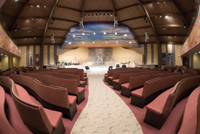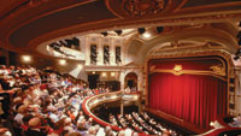

A Tale of Two Churches
Jan 7, 2011 12:00 PM,
By Dan Daley
How to use staging technology to differentiate and market.
Zion Global Ministries in West Chester, Ohio, has a 80’x20’ stage built less than 2ft. off the floor. The church’s sound system is powered by QSC RMX series amps and is mixed through a Yamaha 01V96 digital console.
As if houses of worship didn’t have enough to be worried about in the midst of a pernicious economic downturn. At the May 2009 Pew Forum on Religion & Public Life, political scientists Robert Putnam and David Campbell presented research from their book American Grace, reporting that “young Americans are dropping out of religion at an alarming rate of five to six times the historic rate (30 to 40 percent have no religion today, versus 5 to 10 percent a generation ago).” There has been a corresponding drop in church involvement. According to Rainer Research, approximately 70 percent of American youth drop out of church between the ages of 18 and 22. The Barna Group estimates that 80 percent of those reared in the church will be “disengaged” by the time they are 29.
AV technology is one of the solutions that churches are turning to in an attempt to stem the tide of disaffection. “Unlike our grandparents, the current generation of churchgoer has an overwhelming plethora of choices, and they go shopping,” says Gary Zandstra, sales and marketing manager for integrator Parkway Electric & Communications in Grand Rapids, Mich., and a veteran of HOW AV systems. “What many churches are looking at now is how staging systems can help them differentiate themselves from other churches in the area.”
One of the biggest differences that staging technology can make, systems integrators in this market agree, is in giving small and mid-sized HOWs a more competitive edge in relation to the megachurches that have led the inhouse performance space trend in the last 20 years. People have come to expect sophisticated and elaborate AV systems and stages in such churches as Joel Osteen’s Lakewood Church in Houston, a former NBA arena with a seat count of 16,000, or the 7,400-seat Willow Creek Community Church in South Barrington, Ill., says Chip Allen, a systems designer for ICB Audio & Video. Allen implemented audio, video, and stage systems for Zion Global Ministries in West Chester, Ohio, the 825-seat church where he would ultimately become director of AV.
“Having good sound, light, and video projection systems make a pastor and the congregation feel like, ‘Yeah, we can do that, too,’” Allen says. “Our pastor travels a lot and he hears sound systems in other churches, and when he comes back here, he tells the congregation that he’s so happy to be back in his own church where the sound is so good. It’s a point of pride for everyone, and it’s something that helps keep the church together.”
Zandstra had that same kind of mission for Cornerstone Church in Grand Rapids last year. The church seats 900 worshipers, but its leadership was looking for an outsized staging proposition: It had secured American Idol finalist Matt Giraud for the church venue’s grand opening. The focus of the church is a 40’x70’ proscenium-type stage, raised about 3.5ft. above the floor. “It’s big, but it’s close to the floor, and that’s in keeping with their intent to make the entire venue very intimate and not intimidating,” Zandstra says.

Above the stage, there is an EAW JFX system consisting of four clusters. Two center hangs each have a pair of JFX560i two-way enclosures firing outward and downward. Two exterior hangs have JFX590i enclosures firing in the same configuration. An EAW SB1000zP is mounted on each side of the stage. Inital plans for a line-array system fell apart when the interior designers expressed concern that the system would block the large mural on the ceiling above the stage. Systems designers held firm though on placement at the front of the stage to avoid chronic feedback problems.
“It’s also designed with a curved front edge that gets people in the side seats a sense of being closer to the stage—no seat in the house is more than 75ft. from the stage. It’s also very plain and spare, a lot of space with very little on it built in; there’s no backstage area or side wings to the stage. That gives it a kind of blank canvas effect that lets it become whatever the performance at a particular time needs it to be.”
Performances alternate between traditional and contemporary types of services, with a choir riser wheeled out for the former and guitar amps and drum kits on risers for the latter. It’s also intended to be a competitive performance venue for Christian music artists. “One of the trends that’s going on now is that many of the Christian artists who are not at the level of performing at the regional megachurch or in the local performing arts or civic centers are finding that the mid-sized churches are the perfect size,” Zandstra says. “And that’s like 90 percent of the Christian music market right there.”
At Cornerstone, the stage is deceptively simple. It also has permanently installed 200-amp transformer power that can accommodate typical concert touring systems. Above the stage is a networked Renkus-Heinz PA system: a flown center cluster consisting of a ST8/4-2(T) and a pair of ST6/64 Reference Point array enclosures, installed over the front of the stage, thus allowing front and side audience coverage, while four Renkus-Heinz SGX42 stage lip speakers provide front fill. Four Renkus-Heinz BPS15-2K subwoofers are stacked two per side. Power is via Crown Audio CTs 2000 and amplifiers, as well as QSC CX702 and ISA 750 amps. Speaker management is accomplished with a Symetrix SymNet Express 4×12 DSP system. Audio is mixed through a 32-channel Yamaha M7CL digital console (which also acts as the sound system’s master digital clock device) fitted with an Aviom 16/o-Y1 interface card for the Aviom A-16R rackmount mixer.
A Tale of Two Churches
Jan 7, 2011 12:00 PM,
By Dan Daley
How to use staging technology to differentiate and market.
Cornerstone has a modern layout, and the church’s narthex—the entrance foyer at the opposite end of the church from the stage—is purposely large, configured like a coffeehouse to encourage hanging out and interaction, but also wired into the main PA and with its own separate source distributed sound system through five SoundTube CM500i ceiling speakers.
“This is an important room in the staging strategy of the church because it can handle so many things: overflow from the ‘Big Room,’ as they call the main worship area, but still keep them engaged with what’s going on on-stage. And it acts as its own self-contained space with a club-like atmosphere that also has its own music system,” Zandstra says. “You can plug in a portable mixer and have a small second performance area there.”
Cornerstone’s video projection is large for the space: A 14’x25’ edge-blended image hovers over the rear of the stage flanked by a pair of Da-Lite Screen Company 9’x16’ side screens. A Barco CLM HD8 projector illuminates the main screen, and the two side screens have a pair of Panasonic PT-D6000 video projectors aimed at them. The projection video is used to provide sermon support graphics such as lyrics and background images. “That’s one of the good things about how intimately the stage is with the seating area,” Zandstra says. “The large image on the back wall helps to engulf the parishioners into what is taking place on the main stage.”
Not Biblical Proportions
At the Zion Global Ministries church, the stage technology there is giving a slightly smaller house of worship a boost. It also has a large stage—80ft. wide and 20ft. deep—relative to the facility’s size. The stage is built less than 2ft. off the floor, giving the large performance area an unexpected intimacy. It’s in the congregation’s original building that was completely renovated last year, complete with a waterfall that runs into the church’s baptistery.

The interior design is classically Biblical, designed after a stylized ancient Hebraic temple, but the AV isn’t intrusive. Above the stage is an EAW JFX system composed of four clusters: The two center hangs have a pair each of JFX560i two-way enclosures firing outward and downward, and two exterior hangs have the same configuration of JFX590i speakers. The areas underneath the balcony and in the foyer are filled by 17 JBL Control 26CT ceiling speakers powered by a Crown CDi 1000 amplifier. An EAW SB1000zP is floor-mounted on either side of the stage. The system is powered by QSC RMX series amplifiers and uses a Yamaha SP2060 speaker DSP processor. The audio is mixed through a Yamaha 01V96 digital console. While the sound system’s main mission is worship, it’s also a full-range system capable of handling the Christian and gospel music performances the church also puts on.
In a classic showdown between systems and interior designers, Chip Allen recalls that the decorators feared that the PA system would block the view of the sanctuary’s large skyline mural and asked Allen to hang the PA system towards the rear of the stage. That, of course, would have created instant and chronic feedback problems, so Allen scaled back his initial plans for a line-array-type system in favor of the smaller multiple clusters. But he stood firm on their placement at the front off the stage. “The compromise was we used white speakers,” he says. “I told them, ‘Think of them as clouds.’”
Zion’s projection video consists of two Da-Lite custom fixed-frame 4:3 144”x108” projection screens illuminated with a pair of 5000-lumen Sanyo PLC-ZM5000 projectors fitted with LNS-W20 lenses. The projectors are pole-mounted from the ceiling, with Extron MTP series series Cat-5 baluns for impedance matching. Zion’s projection content is also sermon supportive, using Sermon Assistant software to generate lyrics, scriptural quotes, and image graphics. But, Allen says, that gave them good bang for the buck. “There’s good line of sight from all the seats to the stage, so you can really use the projection video for support rather than reinforcement,” he says.
Since the renovated church reopened, it has hosted a number of concerts. Allen says it’s too soon to tell what beneficial effect the new stage technologies have had yet on the congregation’s fortunes. But he has seen the positive reaction that the systems have instilled in his pastor and the church members. “It gave a real bump in people’s reactions,” he says. “It makes them feel good about the church, and that helps keep a church together. Compared to some other churches, what we have is kind of middle of the road, but it still makes you feel like you’re competitive with other churches. Being able to put entertainment across well is important, especially these days.”









